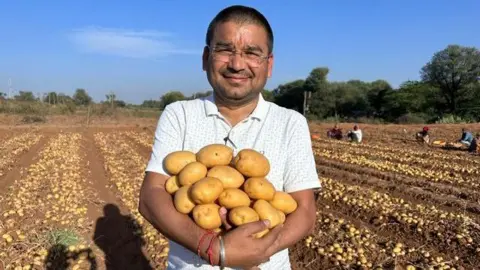### Spud-tacular: How India Became a French Fry Superpower
**Introduction to India’s Potato Potential**
In recent years, India has astonished the world by emerging as a leader in the production of human heart—French fries. This remarkable shift has unfolded in regions like Gujarat, where farming families such as that of Jitesh Patel have transformed their agricultural practices to tap into the burgeoning french fry market. Traditionally, the Patel family cultivated cotton, a crop that became less viable due to poor returns, particularly after droughts hit the region in 2001 and 2002. Faced with adversity, the family sought alternatives that required less water and offered better financial incentives.
**A Groundbreaking Evolution in Agriculture**
Jitesh Patel recalls the urgency of their situation, “We realized that we had to start growing something that does not require a lot of water.” Their gamble started with table potatoes, but those didn’t yield significantly better returns than cotton. However, the turning point came in 2007 when they pivoted to producing specific potato varieties sought after by the food industry. This strategic shift proved to be transformative, as Patel remarked, “Since then, no looking back.”
The rise of Indian potatoes coincided with a global surge in demand for French fries. India is now lauded as the second-largest producer of potatoes globally, with the export market for Indian frozen fries skyrocketing. Major production operations such as McCain Foods and HyFun Foods have established factories in Gujarat, positioning the state as the center of French fry production in India.
**A Surge in French Fry Exports**
From January to February of a notable year, monthly exports from India hit record figures, surpassing 20,000 tonnes for the first time. The total frozen fry exports for that year amounted to an impressive 181,773 tonnes, showcasing a stunning 45% increase compared to the previous year. Devendra K, a longstanding researcher of the potato market, noted that Indian frozen fries are recognized for their competitive pricing—oftenoutpacing even those from China.
HyFun Foods, a leading player in the industry, has faced explosive growth, driven by urbanization, increased disposable income, and changing food consumption patterns. The company operates seven processing plants in Gujarat with plans for additional ones by 2026.
**Innovations in Potato Farming**
To meet growing demand, innovation has been key among farmers. Jitesh Patel, educated in agricultural sciences, applies advanced techniques in his farming operations alongside friends and family. They adopted drip irrigation methods over traditional flooding, allowing for water conservation and improved yield. These steps demonstrate a commitment to sustainable practices in a region known for its arid conditions.
Collaborative efforts with teams like Jain Irrigation Systems have played a crucial role in developing disease-resistant seed potatoes via tissue culture techniques. This method of cloning plants eliminates viruses, thereby ensuring robust crop production. Ongoing research is focused on developing new potato varieties that cater to the needs of the fry-producing sector and combat issues like undesirable sugar levels, which can affect quality.
**Challenges Ahead for the Frozen Food Industry**
Despite the remarkable advancements in potato farming, the frozen food industry in India faces significant obstacles. Although some modern cold storage facilities have been erected, only 10-15% of India’s cold storage is adequate for frozen foods. This deficiency is particularly pronounced in rural areas, where limited access to such facilities hampers the supply chain.
Transportation remains a critical issue. A scarcity of specialized refrigerated trucks amplifies the difficulty of maintaining temperature-controlled transport, leading to potential spoilage during transit. Furthermore, frequent power outages in various regions complicate the cold storage problem and threaten the viability of the frozen food supply chain.
**Conclusion: The Future of French Fries in India**
Back on his farm, Jitesh Patel expresses optimism about the future of potato cultivation in Gujarat. He emphasizes the emergence of the region as a food processing hub, noting the economic security and increased earnings provided through contract farming arrangements. Given the growing global appetite for French fries and the innovative practices being adopted by farmers, India’s position as a significant player in the international food market appears set to strengthen. The country is indeed on track to solidify its status as a French fry superpower, driven by a blend of agricultural ingenuity and market demand.












